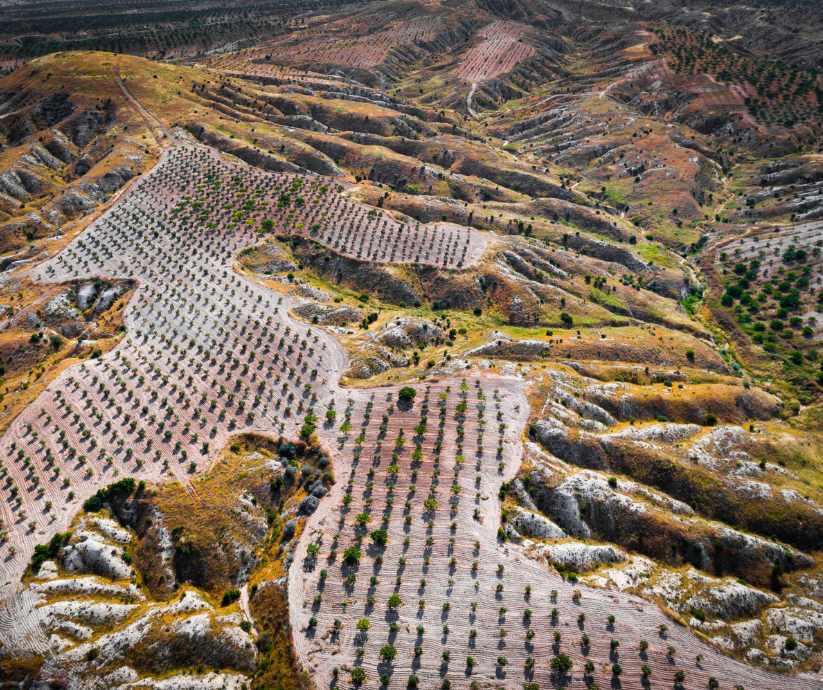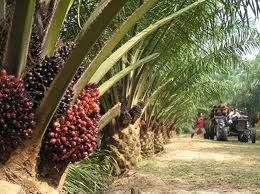Agriculture is expanding throughout the orangutan's range, fragmenting its remaining habitat.
Habitat fragmentation breaks continuous habitat apart through three interrelated processes:
Forests and other natural habitats have been converted for agricultural use for as long as humans have walked the earth, and while most of the focus recently has been on the conversion of tropical rainforests to agricultural plantations, landscapes all throughout the world are still being converted, and in the developed world, natural landscapes are a shadow of their former selves.
Of the 16 million km2 of tropical rainforests that once existed, just around 9 million km2 exists today, with forests in South East Asia disappearing most rapidly. Tropical dry forests along the Central American Pacific coast now cover just 1% of the total land cover they used to, and from 1990 to 2000, over 1% of all mangroves disappeared annually. By 1990, more than two-thirds of Mediterranean forests and woodlands had been lost, mainly for conversion to agriculture.

In the eastern USA and Europe, old-growth broadleaf forests have nearly disappeared. 10-20% of the world’s grasslands have been destroyed for agriculture, and in South America, more than half of the biologically rich cerrado savannas, which formally spanned over 2 million km2, have been converted into soy fields and cattle pastures in recent decades. Over the past three centuries, the global extent of cropland has risen from around 2.7 to 15 million km2 (Laurance, 2010).
The conversion of tropical rainforests for agricultural purposes throughout Indonesia and Malaysia has been immense. Today, approximately 45% of Indonesia’s workers are engaged in agriculture, with 31 million hectares of land under cultivation, 35-40% of which is devoted to producing export crops.
In Indonesia, there are three main types of agricultural farming: smallholder farming, smallholder cash cropping, and about 1,800 large foreign-owned or privately-owned estates. Small-scale farming usually takes place in modest plots and focuses on cultivating rice, vegetables, and fruit for subsistence. However, these products and rubber are also grown as cash crops for export. Of estate-grown crops, rubber, tobacco, sugar, palm oil, hard fiber, coffee, tea, cocoa, and cinchona are the most important (Encyclopedia of the Nations, 2011).
Converting forest to agriculture involves chopping down trees, which leads to biodiversity loss. Although very few animal species can live in any type of plantation, if managed well, plantations can still retain some of the ecosystem functions of tropical rainforests.
In their undisturbed state, tropical rainforests have a virtually closed canopy and millions of different species of trees, leaves and animals. The forest floor is covered in a thin layer of leaf litter that rests on highly permeable topsoil. Thanks to these conditions, they have one of the lowest surface erosion rates of any form of land use. Tropical forests also produce an extraordinary amount of plant biomass because of the compact nutrient cycle of these ecosystems. Plant nutrients enter the forest ecosystem through rain, dust, and aerosols. They cycle continuously between the canopy and the soil, with only small amounts leaking out of the system (Critchley & Bruijnzeel, 1996). This delicately-balanced cycle is disturbed when trees are cut down.
Of all of the methods of clearing trees, manual clearing is the least damaging to the soil. However, it's a slow and expensive method, particularly when large areas of forest need to be cleared. Most plantations use heavy machinery that uproots tree stumps instead. When the timber is extracted, forest debris will often be set on fire because this a cheaper and easier way to clear any remaining vegetation. After clearing, this land will be planted with crops.
The soil quality and productivity on plantations strongly depends on the methods used and the crop being cultivated. Tea, for example, is usually grown in areas with year-round, abundant rainfall and is often cultivated in areas of high altitude, where terraces will be constructed before planting. Tea plantations can last for several decades before production declines. Of all the land use systems that replace tropical rainforests, tea plantations are usually considered one of the most effective with respect to soil erosion because tea trees often grow tall and form a closed canopy. In contrast, coffee trees must be spaced farther apart to allow access for picking and spraying. As a result, coffee plantations have a much sparser canopy and are more susceptible to soil erosion and invasive weeds. Rubber plantations, which are abundant throughout Sumatra, require deep, relatively fertile soil and thrive best on flat land. To establish rubber plantations, the land is clear stumped to avoid disease transmission to the trees. Newly-planted rubber plantations are also susceptible to high levels of erosion and runoff (Critchley & Bruijnzeel, 1996).
When a natural forest is converted to a plantation, the reduction in plant cover increases the amount of water that reaches the ground. When crops and trees start growing again, it can often take years for this water yield to decrease. Even then, crop plantations almost always use less water than original forests, and runoff in areas surrounding plantations are usually discolored with sediment. However, although the process of conversion is highly destructive, a portion of the original ecosystem services can be protected by using appropriate clearing practices and land management techniques such as controlled drainage, bench terraces, contour farming, and introducing biological barriers like hedges or woodland (Critchley & Bruijnzeel, 1996).
 Over the last few decades, palm oil has received the most attention and is considered to have caused the most destruction to primary forests throughout Indonesia and Malaysia. Palm oil is native to Africa and was first planed in Indonesia in 1848. It's suited to tropical regions within 12 to 15 degrees north and south of the equator, where the average rainfall is between 2,000 and 2,500 millimeters per year. Because the palm oil harvest declines during the dry season and the flowering period and maturation of the fruit is affected by temperature, humidity must be between 80 to 90% and the temperature must range between 29 to 30 degrees (Rautner et. al., 2005). Borneo and Sumatra are ideal environments for oil palms. As a result, thousands of hectares habitat for the islands’ orangutans, tigers, elephants, rhino’s, leopards, gibbons, and numerous other species has been converted to make room for this oil.
Over the last few decades, palm oil has received the most attention and is considered to have caused the most destruction to primary forests throughout Indonesia and Malaysia. Palm oil is native to Africa and was first planed in Indonesia in 1848. It's suited to tropical regions within 12 to 15 degrees north and south of the equator, where the average rainfall is between 2,000 and 2,500 millimeters per year. Because the palm oil harvest declines during the dry season and the flowering period and maturation of the fruit is affected by temperature, humidity must be between 80 to 90% and the temperature must range between 29 to 30 degrees (Rautner et. al., 2005). Borneo and Sumatra are ideal environments for oil palms. As a result, thousands of hectares habitat for the islands’ orangutans, tigers, elephants, rhino’s, leopards, gibbons, and numerous other species has been converted to make room for this oil.
Palm oil has the highest per hectare yield of all edible oils and is now the most important vegetable oil in the world. In 2002, palm oil and palm kernel oil accounted for roughly 23% of the world’s edible oil production and 51% of global trade in edible oils. Indonesia is now the world’s largest exporter of palm oil, with Malaysia a close second. Between 2016 and 2020, Indonesia's projected production is around 18,000 million tons, or 44% of world production. Malaysia’s estimated output will be 15,400 million tons, or 37.7% (Rautner et. al., 2005).
Palm oil plantations are usually established after large areas of forest have been cleared by heavy machinery. After the timber has been extracted and sold on the international legal or illegal timber market, leftover debris is usually set alight. The use of fire to clear forest is one of the most destructive practices and is partly responsible for the extensive fires that have ravaged forests throughout Indonesia and Malaysia in recent years, including the devastating fires of 1997 and 1998 (Rautner et. al., 2005; Harrison et. al., 2009).
Pesticides are used to make the trees yield fruit earlier and to control invasive weeds. Highly toxic Paraquat and other pesticides have been blamed for decreased biodiversity in palm oil plantations and for poisoning thousands of plantation workers (Rautner et. al., 2005; WRM, 2005). Converting forests for palm oil plantations results in a loss of 80% of plant species. In palm oil monocultures, research shows that 80-90% of mammals, reptiles, and bird species in tropical forests cannot survive (Rautner et. al. 2005).
The conversion of forests for agriculture is a historic process that is unlikely to stop in the near future. So far in Indonesia, Malaysia, and other parts of the world, this conversion has occurred in lowland areas home to some of the world’s most endangered animals. Preventing future forest loss while considering the needs of a rapidly increasing human population will be one of the greatest environmental challenges of the next few decades.
Hopefully, we can learn lessons from one of the greatest environmental disasters in history - Indonesia’s "Mega Rice Project", a plan by former Indonesian president Suharto to make Indonesia self-sufficient in rice production. The project proposed to convert 796,000 hectares of peat swamp forest in Central Kalimantan into rice fields, with an additional settlement program to relocate 316,000 transmigrant families to the area. No cost-benefit or sensitivity analysis was conducted in advance. In addition, scientists repeatedly warned that the project would fail, and that the depth of the peat made it unsuitable for conversion. Suharto went ahead with the project anyway.
Around $175 million was spent on the scheme, half of which went towards digging canals to drain the peat swamp, which was so deep that it subsided. After Suharto fell from power in 1998, the project was abandoned, and no rice has ever been grown on the land. Today, the Mega Rice Project area is a barren wasteland where transmigrants are unable to grow rice or enough crops to survive, where poverty is rife, where orangutans and other wildlife are scarce and live in fragmented patches of forest. The area is prone to illegal logging and frequent forest fires (Rautner et. al., 2005).
Critchley, W. & Bruijnzeel, S. (1996). Environmental impacts of converting moist tropical forest to agriculture and plantations. UNESCO.
Encyclopedia of the Nations (2011). Indonesia. Encyclopedia of the Nations.
Harrison, M., Paige, S.E. & Limin, S.H. (2009). The global impact of Indonesian forest fires.Biologist, vol 56, 3, pp. 156-163.
Laurance, W.F (2010). Habitat destruction: death by a thousand cuts. In Sodhi, N.S. & Ehrlich, P.R., editors, Conservation biology for all. Oxford University Press, UK.
Rautner, M., Hardiono, M. & Alfred, R.J. (2002). Borneo: Treasure island at risk. WWF.
WRM. (2005). Oil palm plantations: No sustainability possible with Paraquat. World Rainforest Movement.